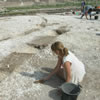
 |
The Big Dig is underway |
One of the UK’s largest archaeological excavations is underway as academic experts and students from BU return to the Dorset countryside to learn more about Iron Age Britain.
The expedition is revealing a great deal about the daily lives of the Durotriges, one of the Celtic tribes living in the area prior to the Roman invasion. Perhaps, more importantly, the expedition could go a long way to dispelling myths about the Roman ‘invasion’ of southern Britain and reveal a closer bond between the visitors and the local Britons of the day.
This is the second year the University’s School of Conservation Sciences has concentrated its efforts on revealing more of the region’s history from beneath the fields near the village of Winterborne Kingston overlooking the Isle of Purbeck. The University's programme of field survey, geophysical investigation and targeted excavation is adding substantially to our knowledge of the transition between the late Iron Age and the early Roman period in southern England.
The site was first drawn to the attention of the University by the landowner who, over 20 or 30 years, discovered pottery and other items.
Three years ago, BU archaeologists John Gale and Dr Miles Russell carried out an initial geophysical survey. A field project carried out by BU’s second year archaeology students the same year discovered a 'banjo' enclosure of the mid-to-late Iron Age. This type of enclosure was previously unknown in this part of Dorset and, to date is the furthest west such a discovery has been made in the UK.
Last year’s field project explored the enclosure and discovered curving ditches which probably date from the Iron Age. Smaller Roman enclosures were also revealed which BU’s Paul Cheetham, believes could be part of a villa estate or outbuildings. The project also uncovered storage pits, demolition debris, a range of pottery, a pre-roman wine amphora and part of a table top made of local Kimmeridge shale.
In particular, various artefacts discovered at the site reveal a harmony between the Romans and Romanised Britons that dispel the image of the Romans as war-like conquerors. For example, a pendant which features a Chi-Ro symbol points to this settlement as a Christian community where the local population lived relatively peacefully with their visitors.
Cheetham explained that the presence of Roman buildings on top of Iron Age enclosure ditches rather complicates matters and produces 'noisy' geophysical results, but hopes that, after studying the results of this year’s investigations, they will be able to show that the transition from Iron Age to Roman was sometimes less violent than was previously supposed.
Dr Russell is certainly convinced that “We might be on the edge of something bigger”.
11/06/10